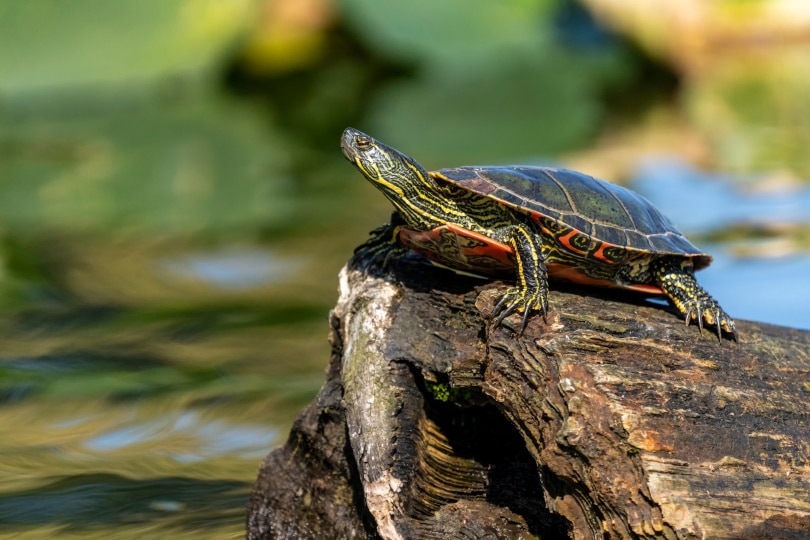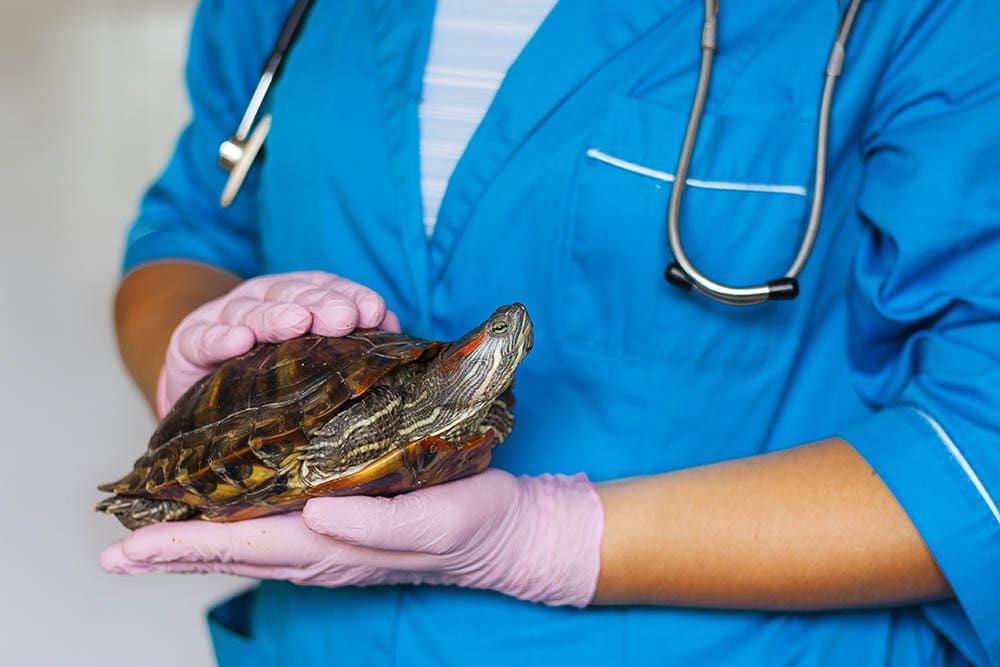
The Western Painted Turtle is one of the most popular turtle breeds due to its colorful patterns and suitableness for inexperienced owners. It’s found all over the United States and is easy to breed in captivity, so it’s easy to find one for your home at a fair price. If you are thinking of purchasing one of these attractive turtles for your home, keep reading while we take a deep dive to learn more about them to see if you are making the right choice.
 Quick Facts About the Western Painted Turtle
Quick Facts About the Western Painted Turtle
| Species Name: | picta |
| Family: | Emydidae |
| Care Level: | Easy |
| Temperature: | 80 – 90 degrees |
| Temperament: | Tame, docile |
| Color Form: | Red, yellow, olive |
| Lifespan: | 30 years |
| Size: | 4 – 10 inches |
| Diet: | Fish, shrimp, plants |
| Minimum Tank Size: | 75 – 125 gallon tank |
| Tank Set-Up: | Basking area, water area, multiple hiding places. |
Western Painted Turtle Overview

You can find the Painted Turtle almost anywhere in the United States if you look hard enough, and you will even find them in parts of Mexico and Canada. The Western variety is easy to find in New Mexico, Oklahoma, Colorado, Idaho, Wyoming, Michigan, and many other states. You will usually find them by rivers, lakes, and streams. They are easy to care for as pets and make a great choice for children and inexperienced owners.
How Much Do Western Painted Turtles Cost?
You can expect to pay $15 – $25 for a baby and $50 -$60 for a juvenile Western Painted Turtle. B Grade turtles can be less expensive because they usually have small imperfections like a damaged tail or broket claw. These types of injuries are very common when there are many baby turtles kept in a small place. B-grade turtles are as healthy as A-grade and cost less, so they can be a great choice for anyone who isn’t entering their pet into competitions.
You will need to provide your Western Painted Turtle with a large habitat that includes water and basking areas to dry off. It’s not hard to create a suitable environment outdoors if you have a small pond or inground fountain, but an indoor environment can get quite expensive.
Typical Behavior & Temperament
Your Western Painted Turtle doesn’t like when you carry it around and will have far fewer stress-related health problems if you only pick it up when necessary. Too much handling can cause your pet to scratch or bite you. More hiding places can help your pet calm down faster, and it enjoys the company of other turtles, but you will need to increase the size of your aquarium to accommodate them.

Appearance & Varieties
Your Western Painted Turtle has an olive green to black carapace that may be mildly or moderately patterned. It will have red or yellow coloring on the seams, and there will be other red highlights as well. The tail, neck, and legs will have red and yellow stripes, and there will be a yellow streak behind each eye.
How to Take Care of a Western Painted Turtle
Habitat, Tank Conditions & Setup
As we mentioned earlier, your Western Painted Turtle will require a somewhat large and varied environment to stay happy. You will need an area with water for your turtle to swim in and another area where it can bask in the sun or under a lamp and dry off. Most experts recommend a 75-gallon tank for females and a 125-gallon tank for females. A small outdoor coy pond or similar can also work well as long as you can seal it from predators.
The Western Painted Turtle is easy to find in several American States, so you won’t need to do too much work to create an environment suitable for optimal health. They prefer the temperature to remain between 80 and 90 degrees in the basking area with water temperatures between 70 and 80 degrees. A UV lamp will help raise the temperature while making sure your pet gets the Ultraviolet light that it requires.

Do Western Painted Turtles Get Along with Other Pets?
The Western Painted Turtle is a calm animal that gets along well with other turtles. It usually tries to avoid confrontation with other animals and often retreats to hiding places if it feels threatened. You can store several painted turtles together, and they will live peacefully, but if you intend to do it in your home, you will need a larger tank.
What to Feed Your Western Painted Turtle
Your Western Painted Turtle will do well on commercial turtle food, but you can also feed them shrimp, fish, vegetables, insects, and more. You can even provide your turtle with several kinds of non-toxic aquatic plants, including water lettuce, pondweed, water lilies, and more. In the wild, your Western Painted Turtle prefers to eat aquatic insects, crustaceans, and algae.
Keeping Your Western Painted Turtle Healthy
If you are keeping your Western Painted Turtle outside, the key to keeping your pet healthy is to protect it from predators and escape by building a well-secure environment. Maintaining an even temperature can help the turtle be comfortable while providing plenty of hiding places can reduce the level of stress your pet is experiencing, and handling them only when necessary is also vital in reducing stress levels

Breeding
Western Painted Turtles will breed between March and June. The Female will dig a nest within 200 yards of a water source to deposit her eggs. She may dig several nests before committing to one and usually lays 1 to 23 eggs before covering the nest with branches and twigs to conceal it. The eggs will hatch in about ten weeks and will automatically know which way to go to reach the nearest water source. If it survives predation, a Western Painted Turtle can live 20 years or more.
Conclusion
The Western Painted Turtle makes a great long-term pet that can live more than 20 years with minimal effort. Getting the environment set up properly will be the most challenging part for many owners, but you will need to do very little besides feeding it and cleaning it once you get it right. It doesn’t like when people pick it up, so it’s not a great choice for people who like to play with their pets, but it’s a great choice for a child and someone looking to gain experience.
We hope you have enjoyed this look into this American turtle and learned some new facts about this easy-to-find animal. If we have convinced you to get one for your home, please share this guide to the Western Painted Turtle on Facebook and Twitter.
Related Reads:
Featured Image Credit: Stephen Bonk, Shutterstock
 Quick Facts About the Western Painted Turtle
Quick Facts About the Western Painted Turtle





